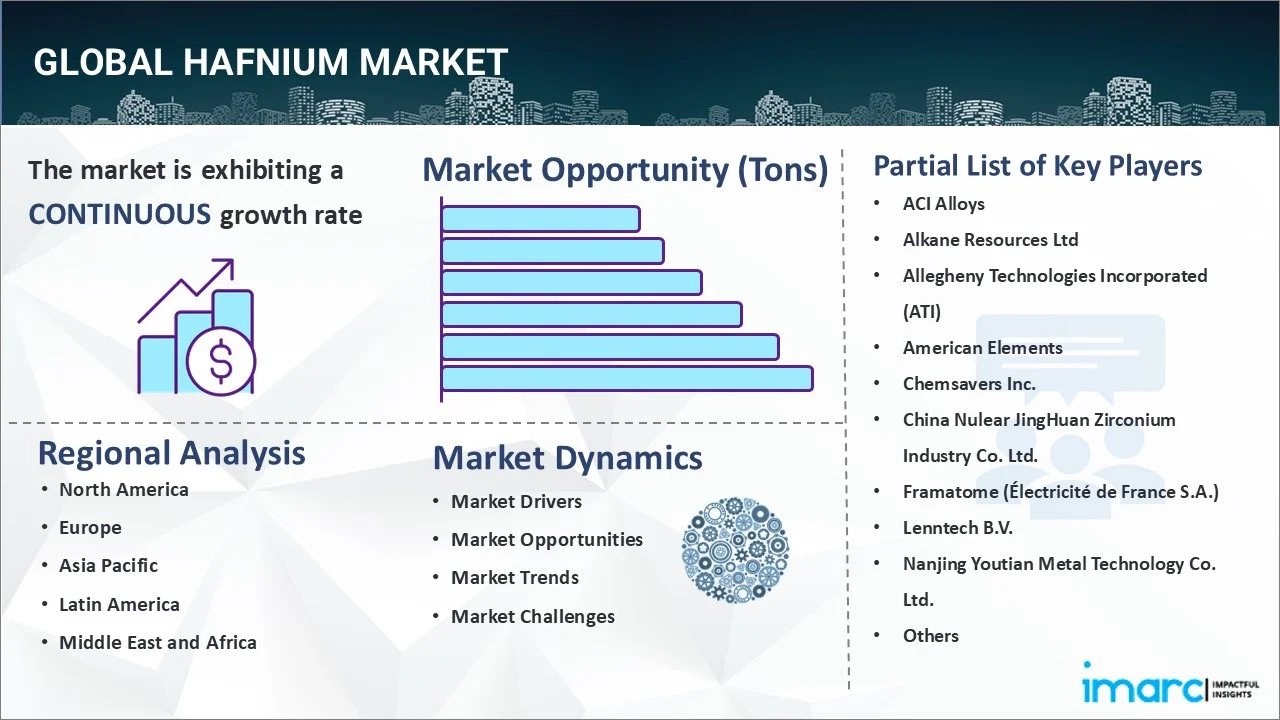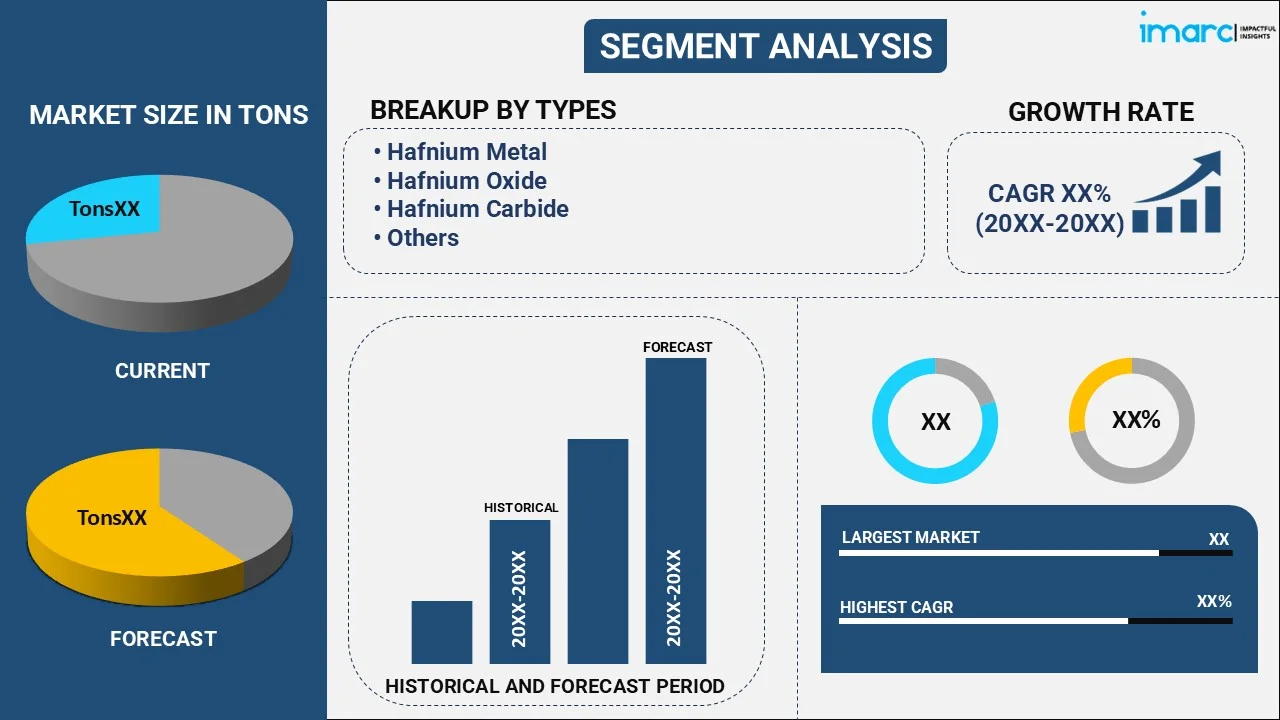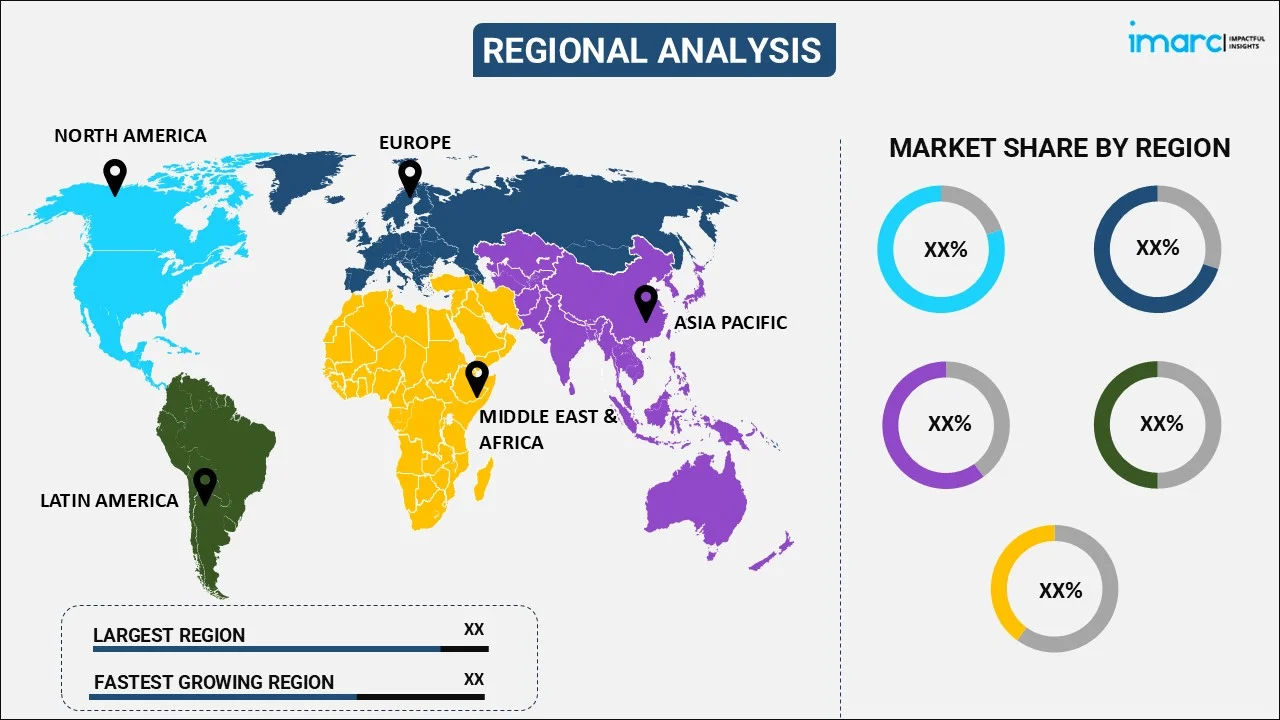
Hafnium Market Report by Type (Hafnium Metal, Hafnium Oxide, Hafnium Carbide, and Others), Application (Super Alloy, Optical Coating, Nuclear, Plasma Cutting, and Others), and Region 2025-2033
Global Hafnium Market:
The global hafnium market size reached 87.9 Tons in 2024. Looking forward, IMARC Group expects the market to reach 136.4 Tons by 2033, exhibiting a growth rate (CAGR) of 5.01% during 2025-2033. The rising demand for superalloys for extensive applications across the aerospace industry is driving the market.
|
Report Attribute
|
Key Statistics
|
|---|---|
|
Base Year
|
2024
|
|
Forecast Years
|
2025-2033
|
|
Historical Years
|
2019-2024
|
|
Market Size in 2024
|
87.9 Tons |
|
Market Forecast in 2033
|
136.4 Tons |
| Market Growth Rate 2025-2033 | 5.01% |
Hafnium Market Analysis:
- Major Market Drivers: Effective allocation of resources, along with the rising applications of this metal in the production of pressurized water reactors, gas turbines, nuclear reactors, and semiconductors, are bolstering the market.
- Key Market Trends: The escalating product demand in optical coatings is fueling the market. Moreover, favorable government incentives are further acting as significant growth-inducing factors.
- Competitive Landscape: Some of the major companies in the market include ACI Alloys, Alkane Resources Ltd, Allegheny Technologies Incorporated (ATI), American Elements, Chemsavers Inc., China Nulear JingHuan Zirconium Industry Co. Ltd., Framatome (Électricité de France S.A.), Lenntech B.V., Nanjing Youtian Metal Technology Co. Ltd., Phelly Materials Inc., and Thermo Fisher Scientific Inc, among many others.
- Geographical Trends: The widespread investments in R&D activities are fueling the market in Europe. Besides this, numerous breakthroughs in the aerospace manufacturing processes are augmenting the regional market.
- Challenges and Opportunities: The scarcity of supply is hindering the market. However, recycling initiatives and the growing exploration efforts are expected to fuel the market in the coming years.

Hafnium Market Trends:
Advancements in the Semiconductor Industry
The shift towards smaller and more efficient electronic devices is driving the market. Moreover, the use of hafnium-based high-k dielectrics enables for the continued miniaturization of transistors, a key component in modern microprocessors. In March 2024, a research team of the DGIST Department of Electrical Engineering and Computer Science introduced a next-generation AI semiconductor technology that mimics the human brain's efficiency in AI and neuromorphic systems. The team developed synaptic field-effect transistors using hafnium oxide. This is expanding the hafnium market analysis report.
Increasing Nuclear Power Generation
As the global emphasis on minimizing carbon emissions rises, nuclear power is being reconsidered as a viable, low-carbon energy source. The shift towards more advanced nuclear technologies, including next-generation reactors and small modular reactors (SMRs), also relies on materials with hafnium's unique properties. In August 2024, India's second home-built 700 MW nuclear power reactor at Kakrapar Atomic Power Station (KAPS) in Gujarat started operating at its full capacity. This is positively influencing the hafnium market outlook report.
Innovations in Material Science
On a chemical level, hafnia is relatively simple. Moreover, it can be ferroelectric, which means it can be used as a non-volatile memory type. In February 2024, a team of scientists from the University of Rochester and another team from the University of Tennessee, Knoxville, collaborated to create a ferroelectric form of hafnium that can be used for data storage. As per the hafnium market forecast report, this is acting as a significant growth-inducing factor.
Global Hafnium Industry Segmentation:
IMARC Group provides an analysis of the key trends in each segment of the market, along with the hafnium market forecast at the global, regional, and country levels for 2025-2033. Our report has categorized the market based on type and application.
Breakup by Type:

- Hafnium Metal
- Hafnium Oxide
- Hafnium Carbide
- Others
Hafnium metal currently holds the largest hafnium market share
The report has provided a detailed breakup and analysis of the market based on the type. This includes hafnium metal, hafnium oxide, hafnium carbide, and others. According to the report, hafnium metal represented the largest market segmentation.
Hafnium metal offers thermal stability, high corrosion resistance, and the ability to absorb neutrons. For example, Intel launched hafnium-based high-k dielectrics in their 45nm processor technology, thereby marking a breakthrough in semiconductor performance and efficiency.
Breakup by Application:
- Super Alloy
- Optical Coating
- Nuclear
- Plasma Cutting
- Others
Super alloy currently holds the largest hafnium market demand
The report has provided a detailed breakup and analysis of the market based on the application. This includes super alloy, optical coating, nuclear, plasma cutting, and others. According to the report, super alloy represented the largest market segmentation.
Hafnium refers to a crucial element in the development of superalloys, particularly for applications requiring exceptional oxidation resistance and high-temperature strength. Rolls-Royce developed a new series of aircraft engines featuring hafnium-containing superalloys.
Breakup by Region:

- North America
- United States
- Canada
- Asia-Pacific
- China
- Japan
- India
- South Korea
- Australia
- Indonesia
- Others
- Europe
- Germany
- France
- United Kingdom
- Italy
- Spain
- Russia
- Others
- Latin America
- Brazil
- Mexico
- Others
- Middle East and Africa
Europe currently dominates the global hafnium market outlook
The hafnium market research report has also provided a comprehensive analysis of all the major regional markets, which include North America (the United States and Canada); Asia Pacific (China, Japan, India, South Korea, Australia, Indonesia, and others); Europe (Germany, France, the United Kingdom, Italy, Spain, Russia and others); Latin America (Brazil, Mexico, and others); and the Middle East and Africa. According to the report, Europe accounted for the largest market share.
Europe exhibited a clear dominance in the market due to the expanding aerospace industry. Moreover, the growing investments in the production of its latest aircraft models are also acting as significant growth-inducing factors. Apart from this, the European Space Agency (ESA) incorporated hafnium into rocket engine components, thereby enhancing the durability and reliability of its spacecraft in extreme conditions.
Competitive Landscape:
The market research report has provided a comprehensive analysis of the competitive landscape. Detailed profiles of all major market companies have also been provided. Some of the key players in the market include:
- ACI Alloys
- Alkane Resources Ltd
- Allegheny Technologies Incorporated (ATI)
- American Elements
- Chemsavers Inc.
- China Nulear JingHuan Zirconium Industry Co. Ltd.
- Framatome (Électricité de France S.A.)
- Lenntech B.V.
- Nanjing Youtian Metal Technology Co. Ltd.
- Phelly Materials Inc.
- Thermo Fisher Scientific Inc.
(Please note that this is only a partial list of the key players, and the complete list is provided in the report.)
Hafnium Market Recent Developments:
- August 2024: India's second home-built 700 MW nuclear power reactor at Kakrapar Atomic Power Station (KAPS) in Gujarat started operating at its full capacity.
- March 2024: A research team of the DGIST Department of Electrical Engineering and Computer Science introduced a next-generation AI semiconductor technology that mimics the human brain's efficiency in AI and neuromorphic systems. The team developed synaptic field-effect transistors using hafnium oxide.
- February 2024: Scientists from the University of Rochester and another team from the University of Tennessee, Knoxville, collaborated to create a ferroelectric form of hafnium that can be used for data storage.
Hafnium Market Report Scope:
| Report Features | Details |
|---|---|
| Base Year of the Analysis | 2024 |
| Historical Period | 2019-2024 |
| Forecast Period | 2025-2033 |
| Units | Million USD, Tons |
|
Scope of the Report |
Exploration of Historical Trends and Market Outlook, Industry Catalysts and Challenges, Segment-Wise Historical and Predictive Market Assessment:
|
| Types Covered | Hafnium Metal, Hafnium Oxide, Hafnium Carbide, Others |
| Applications Covered | Super Alloy, Optical Coating, Nuclear, Plasma Cutting, Others |
| Regions Covered | Asia Pacific, Europe, North America, Latin America, Middle East and Africa |
| Countries Covered | United States, Canada, Germany, France, United Kingdom, Italy, Spain, Russia, China, Japan, India, South Korea, Australia, Indonesia, Brazil, Mexico |
| Companies Covered | ACI Alloys, Alkane Resources Ltd, Allegheny Technologies Incorporated (ATI), American Elements, Chemsavers Inc., China Nulear JingHuan Zirconium Industry Co. Ltd., Framatome (Électricité de France S.A.), Lenntech B.V., Nanjing Youtian Metal Technology Co. Ltd., Phelly Materials Inc., Thermo Fisher Scientific Inc., etc. |
| Customization Scope | 10% Free Customization |
| Post-Sale Analyst Support | 10-12 Weeks |
| Delivery Format | PDF and Excel through Email (We can also provide the editable version of the report in PPT/Word format on special request) |
Key Benefits for Stakeholders:
- IMARC's industry report offers a comprehensive quantitative analysis of various market segments, historical and current market trends, market forecasts, and dynamics of the hafnium market from 2019-2033.
- The research report provides the latest information on the market drivers, challenges, and opportunities in the global hafnium market.
- The study maps the leading, as well as the fastest-growing, regional markets. It further enables stakeholders to identify the key country-level markets within each region.
- Porter's five forces analysis assists stakeholders in assessing the impact of new entrants, competitive rivalry, supplier power, buyer power, and the threat of substitution. It helps stakeholders to analyze the level of competition within the hafnium industry and its attractiveness.
- The competitive landscape allows stakeholders to understand their competitive environment and provides insight into the current positions of key players in the market.
Key Questions Answered in This Report
The global hafnium market reached a volume of 87.9 Tons in 2024.
We expect the global hafnium market to exhibit a CAGR of 5.01% during 2025-2033.
The rising utilization of hafnium to produce gas turbines, nuclear reactors, pressurized water reactors, semiconductors, etc., owing to its large cross-section and excellent welding and processing properties, is primarily driving the global hafnium market.
The sudden outbreak of the COVID-19 pandemic had led to the implementation of stringent lockdown regulations across several nations, resulting in the temporary halt in numerous production activities for hafnium.
Based on the type, the global hafnium market has been segregated into hafnium metal, hafnium oxide, hafnium carbide, and others. Among these, hafnium metal currently holds the largest market share.
Based on the application, the global hafnium market can be bifurcated into super alloy, optical coating, nuclear, plasma cutting, and others. Currently, the super alloy exhibits a clear dominance in the market.
On a regional level, the market has been classified into North America, Asia-Pacific, Europe, Latin America, and Middle East and Africa, where Europe currently dominates the global market.
Some of the major players in the global hafnium market include ACI Alloys, Alkane Resources Ltd, Allegheny Technologies Incorporated (ATI), American Elements, Chemsavers Inc., China Nulear JingHuan Zirconium Industry Co. Ltd., Framatome (Électricité de France S.A.), Lenntech B.V., Nanjing Youtian Metal Technology Co. Ltd., Phelly Materials Inc., and Thermo Fisher Scientific Inc.
Need more help?
- Speak to our experienced analysts for insights on the current market scenarios.
- Include additional segments and countries to customize the report as per your requirement.
- Gain an unparalleled competitive advantage in your domain by understanding how to utilize the report and positively impacting your operations and revenue.
- For further assistance, please connect with our analysts.
 Inquire Before Buying
Inquire Before Buying
 Speak to an Analyst
Speak to an Analyst
 Request Brochure
Request Brochure
 Request Customization
Request Customization




.webp)




.webp)












